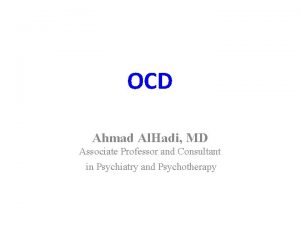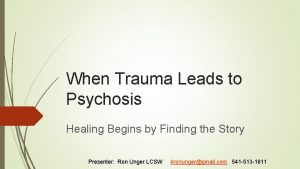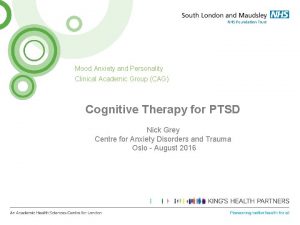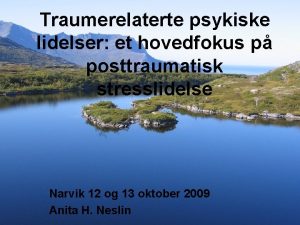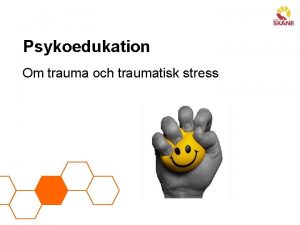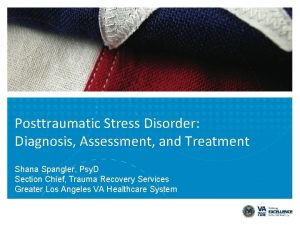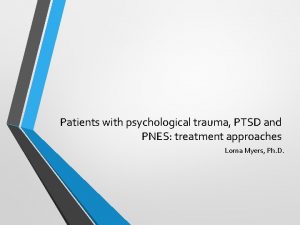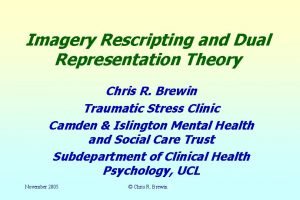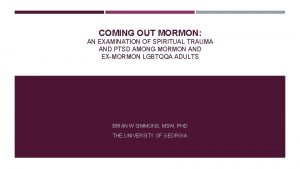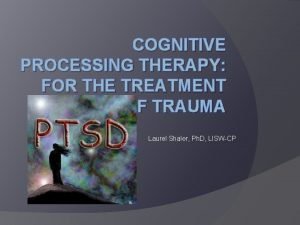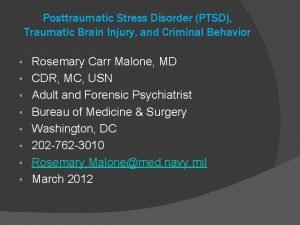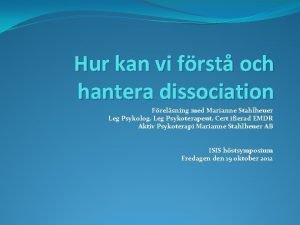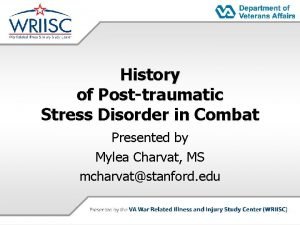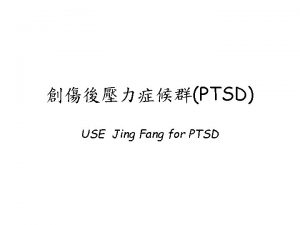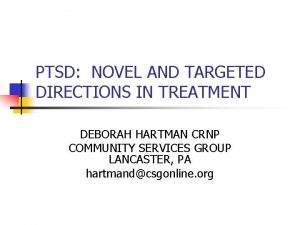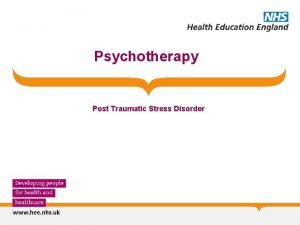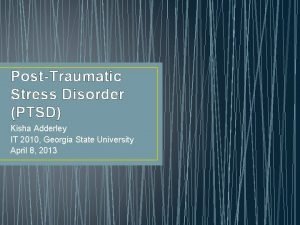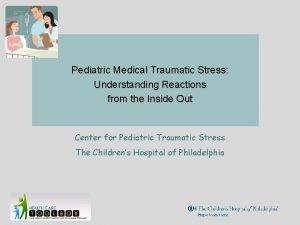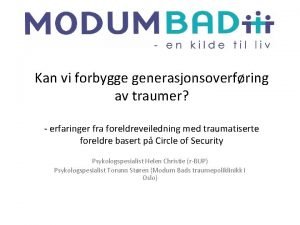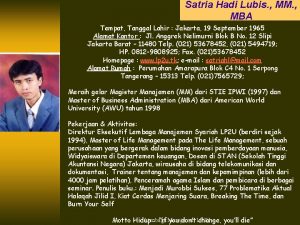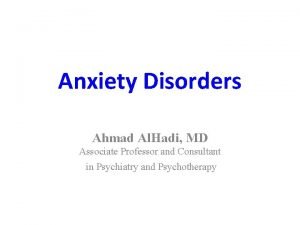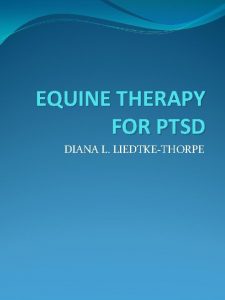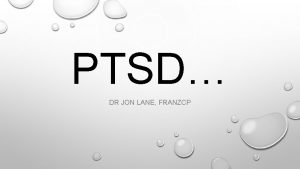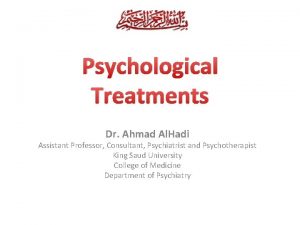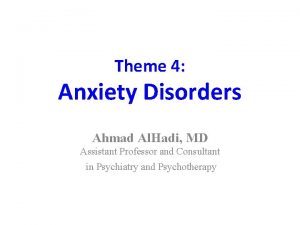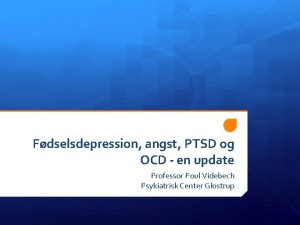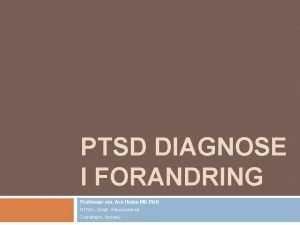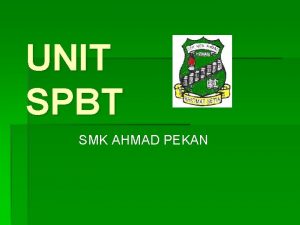PTSD Ahmad Al Hadi MD Associate Professor and


























- Slides: 26

PTSD Ahmad Al. Hadi, MD Associate Professor and Consultant in Psychiatry and Psychotherapy

Objectives: • List the diagnostic criteria for PTSD according to DSM 5. • Discuss the prevalence and causes of PTSD. • Discuss the treatment plan.

Case development • Also, her brother Saad, has the same symptoms of Layla whenever he is exposed to cues that remind him with the car accident that he had 2 years ago. Saad had serious injuries in that accident and he was in coma for 3 weeks. His friend died in the same accident. He also has flashbacks related to that accident. Also, he refuses to talk about the accident and avoids drive in the street where the accident happened.

• Also, her brother Saad, has the same symptoms of Layla whenever he is exposed to cues that remind him with the car accident that he had 2 years ago. Saad had serious injuries in that accident and he was in coma for 3 weeks. His friend died in the same accident. He also has flashbacks related to that accident. Also, he refuses to talk about the accident and avoids drive in the street where the accident happened.

Anxiety Disorders 1. 2. 3. 4. 5. 6. 7. Panic Disorder Agoraphobia Specific Phobia Social Phobia. Generalized Anxiety Disorder (GAD) Obsessive Compulsive Disorder (OCD) Post Traumatic Stress Disorder (PTSD), Acute Stress Disorder

Re-experience • Flash backs • Nightmares • Hallucinations • Cues Changes in Mood & Cognitions • Amnesia • negative beliefs • distorted cognitions blame • negative emotional state • diminished interest • Detachment • Persistent inability to experience positive emotions Avoidance Arousal • Memories, thoughts, or feelings • Place, People, Conversations • Sleep • Hypervigilance • Irritability • Anger TRAUMA

Acute stress disorder and PTSD • After exposure to traumatic life events. • Duration > a month after the event. • Acute stress disorder: occurs earlier than PTSD (within 4 weeks of the event) and remits within 2 days to 4 weeks. • Must significantly affect important areas of life (family and work) TRAUMA ASD 1 month PTSD


PTSD DSM 5 Note: The following criteria apply to adults, adolescents, and children older than 6 years. For children 6 years and younger, see corresponding criteria below. A. Exposure to actual or threatened death, serious injury, or sexual violence in one (or more) of the following ways: 1. Directly experiencing the traumatic event(s). 2. Witnessing, in person, the event(s) as it occurred to others. 3. Learning that the traumatic event(s) occurred to a close family member or close friend. In cases of actual or threatened death of a family member or friend, the event(s) must have been violent or accidental. 4. Experiencing repeated or extreme exposure to aversive details of the traumatic event(s) (e. g. , first responders collecting human remains: police officers repeatedly exposed to details of child abuse). Note: Criterion A 4 does not apply to exposure through electronic media, television, movies, or pictures, unless this exposure is work related.

PTSD DSM 5 B. Presence of one (or more) of the following intrusion symptoms associated with the traumatic event(s), beginning after the traumatic event(s) occurred: 1. Recurrent, involuntary, and intrusive distressing memories of the traumatic event(s). Note: In children older than 6 years, repetitive play may occur in which themes or aspects of the traumatic event(s) are expressed. 2. Recurrent distressing dreams in which the content and/or affect of the dream are related to the traumatic event(s). Note: In children, there may be frightening dreams without recognizable content. 3. Dissociative reactions (e. g. , flashbacks) in which the individual feels or acts as if the traumatic event(s) were recurring. (Such reactions may occur on a continuum, with the most extreme expression being a complete loss of awareness of present surroundings. )Note: In children, trauma specific reenactment may occur in play. 4. Intense or prolonged psychological distress at exposure to internal or external cues that symbolize or resemble an aspect of the traumatic event(s). 5. Marked physiological reactions to internal or external cues that symbolize or resemble an aspect of the traumatic event(s).

PTSD DSM 5 C. Persistent avoidance of stimuli associated with the traumatic event(s), beginning after the traumatic event(s) occurred, as evidenced by one or both of the following: 1. Avoidance of or efforts to avoid distressing memories, thoughts, or feelings about or closely associated with the traumatic event(s). 2. Avoidance of or efforts to avoid external reminders (people, places, conversations, activities, objects, situations) that arouse distressing memories, thoughts, or feelings about or closely associated with the traumatic event(s).

PTSD DSM 5 D. Negative alterations in cognitions and mood associated with the traumatic event(s), beginning or worsening after the traumatic event(s) occurred, as evidenced by two (or more) of the following: 1. Inability to remember an important aspect of the traumatic event(s) (typically due to dissociative amnesia and not to other factors such as head injury, alcohol, or drugs). 2. Persistent and exaggerated negative beliefs or expectations about oneself, others, or the world (e. g. , “I am bad, ” “No one can be trusted, ” ‘The world is completely dangerous, ” “My whole nervous system is permanently ruined”). 3. Persistent, distorted cognitions about the cause or consequences of the traumatic event(s) that lead the individual to blame himself/herself or others. 4. Persistent negative emotional state (e. g. , fear, horror, anger, guilt, or shame). 5. Markedly diminished interest or participation in significant activities. 6. Feelings of detachment or estrangement from others. 7. Persistent inability to experience positive emotions (e. g. , inability to experience happiness, satisfaction, or loving feelings).

PTSD DSM 5 E. Marked alterations in arousal and reactivity associated with the traumatic event(s), beginning or worsening after the traumatic event(s) occurred, as evidenced by two (or more) of the following: 1. Irritable behavior and angry outbursts (with little or no provocation) typically expressed as verbal or physical aggression toward people or objects. 2. Reckless or self destructive behavior. 3. Hyper vigilance. 4. Exaggerated startle response. 5. Problems with concentration. 6. Sleep disturbance (e. g. , difficulty falling or staying asleep or restless sleep).

PTSD DSM 5 F. Duration of the disturbance (Criteria B, C, D, and E) is more than 1 month. G. The disturbance causes clinically significant distress or impairment in social, occupa tional, or other important areas of functioning. H. The disturbance is not attributable to the physiological effects of a substance (e. g. , medication, alcohol) or another medical condition. Specify whether: With dissociative symptoms: The individual’s symptoms meet the criteria for post traumatic stress disorder, and in addition, in response to the stressor, the individual experiences persistent or recurrent symptoms of either of the following: 1. Depersonalization: Persistent or recurrent experiences of feeling detached from, and as if one were an outside observer of, one’s mental processes or body (e. g. , feeling as though one were in a dream; feeling a sense of unreality of self or body or of time moving slowly). 2. Derealization: Persistent or recurrent experiences of unreality of surroundings (e. g. , the world around the individual is experienced as unreal, dreamlike, distant, or distorted). Note: To use this subtype, the dissociative symptoms must not be attributable to the physiological effects of a substance (e. g. , blackouts, behavior during alcohol intoxication) or another medical condition (e. g. , complex partial seizures). Specify if: With delayed expression: If the full diagnostic criteria are not met until at least 6 months after the event (although the onset and expression of some symptoms may be immediate).

PTSD epidemiology • The lifetime prevalence: – 8 % of the general population. – up to 75 % in high risk groups whose experienced traumatic events. – 5 to 15 % may experience subclinical forms of the disorder. • The most important risk factors are the severity, duration, and proximity of a person's exposure to the actual trauma. • Risk Factors: single, divorced, widowed, socially withdrawn, or of low socioeconomic level.

Comorbidity • High rates • Two thirds (66%) having at least two other disorders. • Common: – – depressive disorders substance related disorders other anxiety disorders bipolar disorders.

Prognosis • Fluctuate over time and may be most intense during periods of stress. • Untreated, – – about 30 percent of patients recover completely, 40 percent continue to have mild symptoms, 20 percent continue to have moderate symptoms, 10 percent remain unchanged or become worse. • After 1 year, about 50 percent of patients will recover. • A good prognosis – – – rapid onset of the symptoms, short duration of the symptoms (less than 6 months), good pre morbid functioning, strong social supports absence of other psychiatric, medical, or substance related disorders or other risk factors.

Adjustment Disorders • The adjustment disorders: emotional response to a stressful event. • The stressor involves financial issues, a medical illness, or a relationship problem. • The symptoms must begin within 3 months of the stressor and must remit within 6 months of removal of the stressor.

Adjustment Disorders DSM 5 A. The development of emotional or behavioral symptoms in response to an identifiable stressor(s) occurring within 3 months of the onset of the stressor(s). B. These symptoms or behaviors are clinically significant, as evidenced by one or both of the following: 1. Marked distress that is out of proportion to the severity or intensity of the stressor, taking into account the external context and the cultural factors that might influence symptom severity and presentation. 2. Significant impairment in social, occupational, or other important areas of functioning. C. The stress related disturbance does not meet the criteria for another mental disorder and is not merely an exacerbation of a preexisting mental disorder.

Adjustment Disorders DSM 5 D. The symptoms do not represent normal bereavement. E. Once the stressor or its consequences have terminated, the symptoms do not persist for more than an additional 6 months. Specify whether: With depressed mood: Low mood, tearfulness, or feelings of hopelessness are predominant. With anxiety: Nervousness, worry, jitteriness, or separation anxiety is predominant. With mixed anxiety and depressed mood: A combination of depression and anxiety is predominant. With disturbance of conduct: Disturbance of conduct is predominant. With mixed disturbance of emotions and conduct: Both emotional symptoms (e. g. , depression, anxiety) and a disturbance of conduct are predominant. Unspecified: For maladaptive reactions that are not classifiable as one of the specific subtypes of adjustment disorder.

Course and Prognosis • With appropriate treatment, the overall prognosis of an adjustment disorder is generally favorable. • Most patients return to their previous level of functioning within 3 months. • Some persons (particularly adolescents) who receive a diagnosis of an adjustment disorder later have mood disorders or substance related disorders. Adolescents usually require a longer time to recover than adults.

Bereavement, Grief, and Mourning • Psychological reactions of those who survive a significant loss. • Mourning is the process by which grief is resolved. • Bereavement literally means the state of being deprived of someone by death and refers to being in the state of mourning.

Normal Bereavement Reactions • Stage 1: Shock and Denial • Stage 2: Anger • Stage 3: Bargaining • Stage 4: Depression • Stage 5: Acceptance


SUMMARY: Bereavement or depression ? • In bereavement : – NO morbid feelings of guilt and worthlessness, suicidal ideation, or psychomotor retardation. – Dysphoria often triggered by thoughts or reminders of the deceased. – Onset is within the first 2 months of bereavement. – Duration of depressive symptoms is less than 2 months. – Functional impairment is transient and mild. – No family or personal history of major depression.

 Promotion from associate professor to professor
Promotion from associate professor to professor Hadi ahmad md
Hadi ahmad md Psychosis and ptsd
Psychosis and ptsd Ptsd model ehlers and clark
Ptsd model ehlers and clark Ptsd norsk
Ptsd norsk Macbeth ptsd quotes
Macbeth ptsd quotes Psykoedukation trauma
Psykoedukation trauma Va ptsd rating scale pdf
Va ptsd rating scale pdf Ptsd seizures
Ptsd seizures Dual representation theory
Dual representation theory Ptsd spiritual warfare
Ptsd spiritual warfare Ptsd a-b-c worksheets examples
Ptsd a-b-c worksheets examples Sun stunned sand smothered land
Sun stunned sand smothered land Ptsd violent behavior
Ptsd violent behavior Frelsning
Frelsning Evolution of ptsd
Evolution of ptsd Ptsd
Ptsd Jamal and deborah therapy
Jamal and deborah therapy C ptsd
C ptsd Causes of ptsd
Causes of ptsd Ptsd stages
Ptsd stages Kompleks ptsd trigger
Kompleks ptsd trigger Circumcision ptsd
Circumcision ptsd Ustadz satria hadi lubis
Ustadz satria hadi lubis Dr nur mohammad hadi zahalan
Dr nur mohammad hadi zahalan Good morning nice to see you
Good morning nice to see you Yulianto hadi
Yulianto hadi

